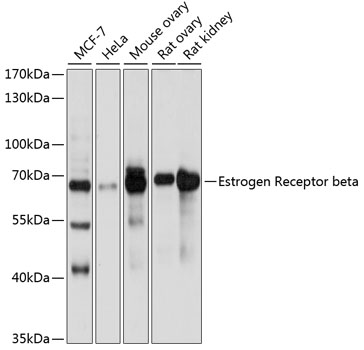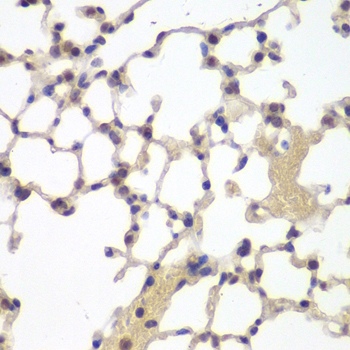-
Product Name
Estrogen Receptor beta Polyclonal Antibody
- Documents
-
Description
Polyclonal antibody to Estrogen Receptor beta
-
Tested applications
WB, IHC
-
Species reactivity
Human, Mouse, Rat
-
Alternative names
ESR2 antibody; ER-BETA antibody; ESR-BETA antibody; ESRB antibody; ESTRB antibody; Erb antibody; NR3A2 antibody; estrogen receptor 2 antibody
-
Isotype
Rabbit IgG
-
Preparation
Antigen: Recombinant fusion protein containing a sequence corresponding to amino acids 1-280 of human Estrogen Receptor beta (NP_001201832.1).
-
Clonality
Polyclonal
-
Formulation
PBS with 0.02% sodium azide, 50% glycerol, pH7.3.
-
Storage instructions
Store at -20℃. Avoid freeze / thaw cycles.
-
Applications
WB 1:500 - 1:2000
IHC 1:50 - 1:200 -
Validations

Western blot - Estrogen Receptor beta Polyclonal Antibody
Western blot analysis of extracts of various cell lines, using Estrogen Receptor beta antibody at 1:500 dilution.Secondary antibody: HRP Goat Anti-Rabbit IgG (H+L) at 1:10000 dilution.Lysates/proteins: 25ug per lane.Blocking buffer: 3% nonfat dry milk in TBST.Detection: ECL Basic Kit .Exposure time: 5s.

Immunohistochemistry - Estrogen Receptor beta Polyclonal Antibody
Immunohistochemistry of paraffin-embedded mouse lung using Estrogen Receptor beta antibody at dilution of 1:200 (40x lens).
-
Background
Nuclear hormone receptor. Binds estrogens with an affinity similar to that of ESR1, and activates expression of reporter genes containing estrogen response elements (ERE) in an estrogen-dependent manner. Isoform beta-cx lacks ligand binding ability and has no or only very low ere binding activity resulting in the loss of ligand-dependent transactivation ability. DNA-binding by ESR1 and ESR2 is rapidly lost at 37 degrees Celsius in the absence of ligand while in the presence of 17 beta-estradiol and 4-hydroxy-tamoxifen loss in DNA-binding at elevated temperature is more gradual.
Related Products / Services
Please note: All products are "FOR RESEARCH USE ONLY AND ARE NOT INTENDED FOR DIAGNOSTIC OR THERAPEUTIC USE"
